Ok, let’s make this quick: Corned beef has nothing to do with corn, corned beef and cabbage isn’t a traditional Irish dish, and New England corned beef just looks awful.
But man oh man, is corned beef something. I regret that we only really talk about it this time of year; it’s the kind of treat that can be enjoyed year-round. Make it in the “traditional” (more on that in a bit) way with carrots and cabbage, chop it up and mix it into a delightful hash, or pile it high on the greatest sandwich of all time, the Reuben.
(Related note: I have discovered that a Reuben, in its purest sense, is made with corned beef. I also thought corned beef and pastrami were interchangeable in this regard, but I’ve been corrected. Regardless, I love pastrami as well, so I’m including a bonus recipe at the bottom here for making your corned brisket into pastrami instead. Or, like I’m doing this year, make ’em both.)
Or do other crazy inventive things with it. This year, we’re going to try corned beef and cabbage egg rolls. Results pending.
But whatever you do with it, please please please follow my guidance here and do it yourself. Yes, it takes 5-7 days. But you’re really only doing about 30 minutes of work in there, and the results are infinitely superior to this sad product you bring home every year:
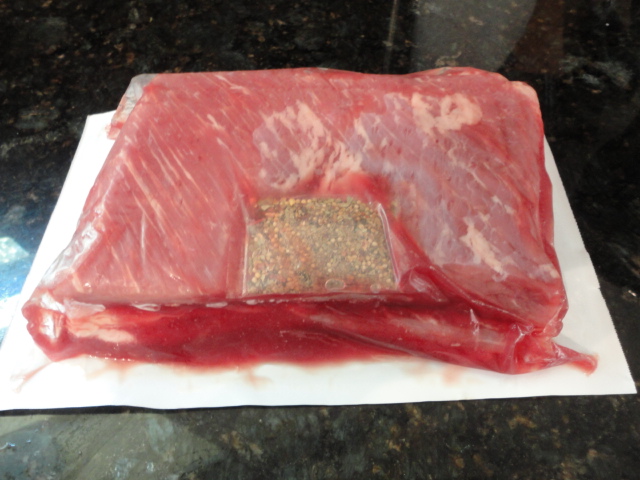
Seriously, give yourself some credit. You’re capable of so much more.
Before I show you how easy it is, know this about corned beef:
- It’s not really a traditional Irish dish. It does have Irish roots, but it’s more of an Irish-American thing. Corned beef was traditionally made in Ireland because the cattle was plentiful and the salt tax (yes, that’s a real thing) was about 1/10 of that of England. Because of this, Irish farmers were able to import the finest salts around, but sadly, most of the Irish couldn’t afford the finished product. It wasn’t until they moved to the States in the 1840s and 1850s that they found it affordable. (There’s plenty more to this story, but I’m too hungry to explain, and it’s making me want to get to the recipe. Check out the stories here and here.)
- The term “corned” refers to the large grains of salt used to cure the meat; it’s derived from an old English word that described small particles or grains.
- Around Boston, where we traditionally think of the Irish (I guess because of the Celtics?), their corned beef is gray instead of pink. Just like everything I assume about New England, it looks just a little sadder and depressed.
Now that the very brief trivia segment is out of the way, let’s talk about making this corned beef a reality. BTW, quick segue from depressing New England to a tip for not killing yourself while making this recipe:
Pink curing salt, aka Prague Powder #1, is used in this recipe to aid the curing process. It’s what gives corned beef that distinctive pink color, but it’s also loaded with sodium nitrite, which is TOXIC if ingested directly. So please, use it only as directed and keep it locked up at all times so you don’t mistakenly sprinkle it on your french fries. It is not the same as pink Himalayan salt, and it is very much a dangerous compound.
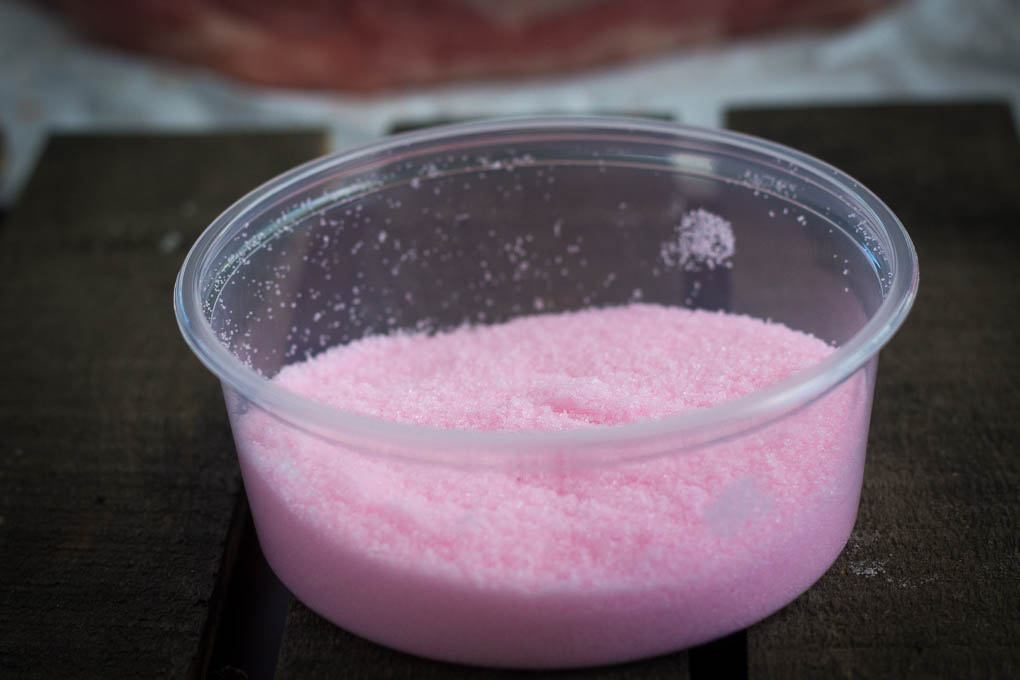
Having said that, don’t freak out. If you use it as described, it’s completely safe and has been used successfully for generations. We’re good.
CORN THAT BEEF, YO
The process of corning the beef is actually quite simple. Here’s how you start:
- Get yourself a nice beef brisket, and trim the excess fat. This recipe is built around a 4-pound brisket, so adjust spices and such accordingly if you go bigger.
- Order some pink curing salt (or grab some from your butcher). Make sure you’re grabbing Prague Powder #1 and not Prague Powder #2 (#2 is generally not available freely, but it’s important to keep in mind). Prague Powder #2 is used more for long-term curing (e.g., months instead of days), and the sodium nitrites break down a lot slower.
- Gather some other basic ingredients, including pickling spice (my easy recipe blend can be found here).
Easy enough.
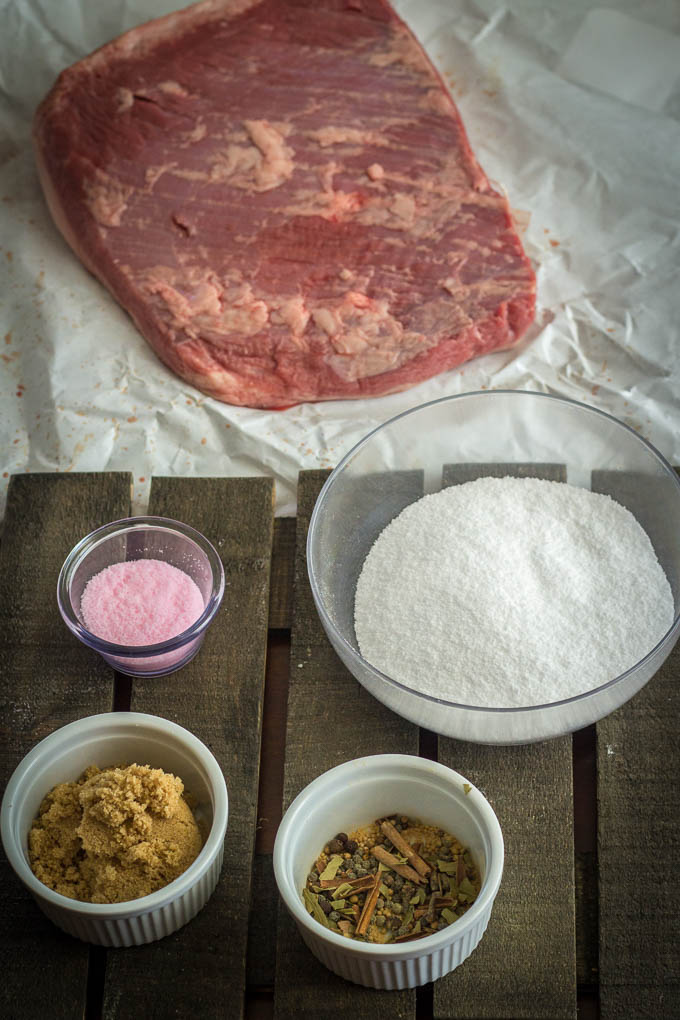
Procedure: Simple.
- Mix the pink curing salt, 12 oz (by weight) of kosher salt, sugar, pickling spice, and water together and cook over medium-high heat until the sugar and salts are dissolved.
- Turn off the heat and walk away for a bit. A bit being long enough til the brine cools completely, so make that like an hour.
- Put the brisket into a ziploc bag and cover it with the brine. Zip it up.
- Stash it in the fridge for 5-7 days, turning it over every day to make sure everything stays covered.
COOK IT, YO
So it’s a week later and you wanna eat this thing. You have a few options for cooking it, all of which are pretty straightforward.
No matter what you choose, start by removing the brisket from the fridge and rinsing it off in cold water. Pat it try with some paper towels and get it ready for the heat. Add a good amount of this spice rub:
- 2 tsp coriander seeds
- 2 tsp black peppercorns
- 1 tsp dill seed
- 1 tsp mustard seed
- 1/4 tsp ground clove
- 1 bay leaf, crushed
Grind those together in a spice grinder and rub it on the meat after it’s been rinsed and dried.
Here are the best options, as I see them:
- Sous vide: My personal favorite. We did this last year for the first time and the results were sublime. Just like any other sous vide recipe, though, give yourself plenty of time. Put the brisket in a vacuum-sealed bag and cook at 170 for 10 hours.
- Slow cooker: As easy as can be. Put the brisket in a slow cooker with some carrots, onions, potatoes, etc., Cover it with water and add an extra teaspoon of pickling spice, and cook it high for 8 hours.
- Oven: Put the brisket in a baking dish and add about an inch of water (and/or beer), then cover with foil and cook at 275 degrees for 4-5 hours (about an hour per pound, maybe a bit more). You’re looking for an internal temperature of 180-185 for a good level of doneness.
Now, standard procedure. Let it rest. Cut it across the grain. Devour.
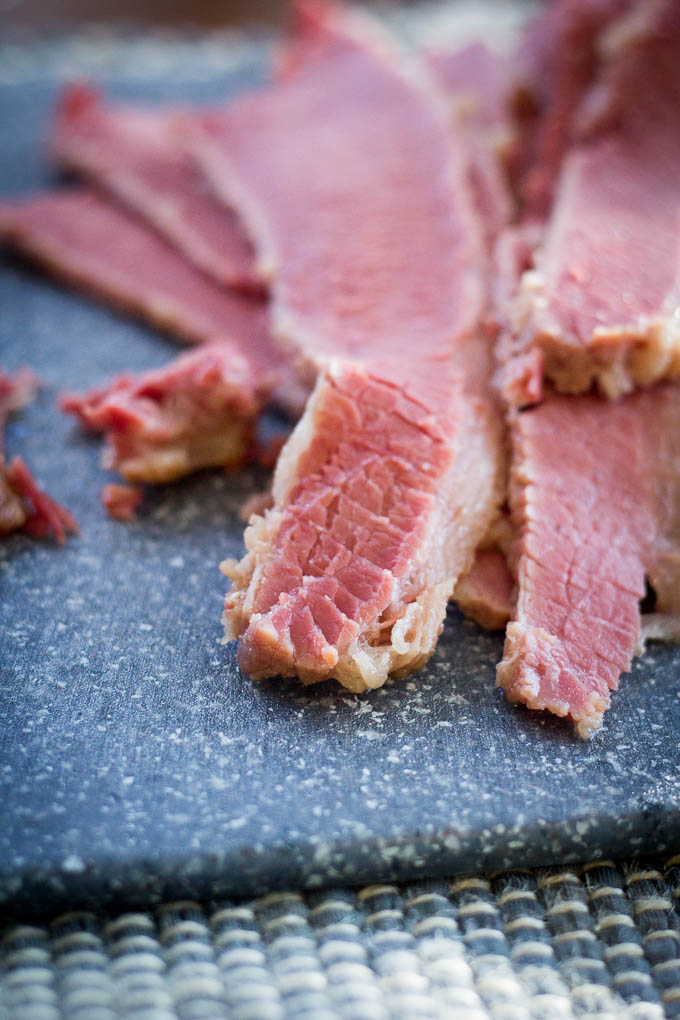
BONUS TIME: PASTRAMI
So, pastrami is great too. Maybe better? No need to debate; let’s just make them both.
Before you start your corned beef, split your brisket in half. Do the same procedure for both; the only difference will occur when it’s time to cook.
As with the corned beef, remove it from the fridge after 5 days and rinse it thoroughly. Then give it a good rub down with this spice mixture:
- 2 parts coriander seeds, ground
- 2 parts black peppercorns, ground
- 1 part smoked paprika
Then cook it in the oven at 275, covered — or my preferred method, smoke it — til it reaches an internal temperature of 185 degrees. Probably a little over an hour a pound if in the oven, and who-knows-how-long in the smoker. Guess it depends on how much heat you’ve got going, but that’s kinda the beauty of using the smoker, right?
(I won’t leave you hanging with just that explanation. Smoke it between 225 and 250 degrees — this’ll put you in the 6-8 hour range for total time.)
Enjoy.
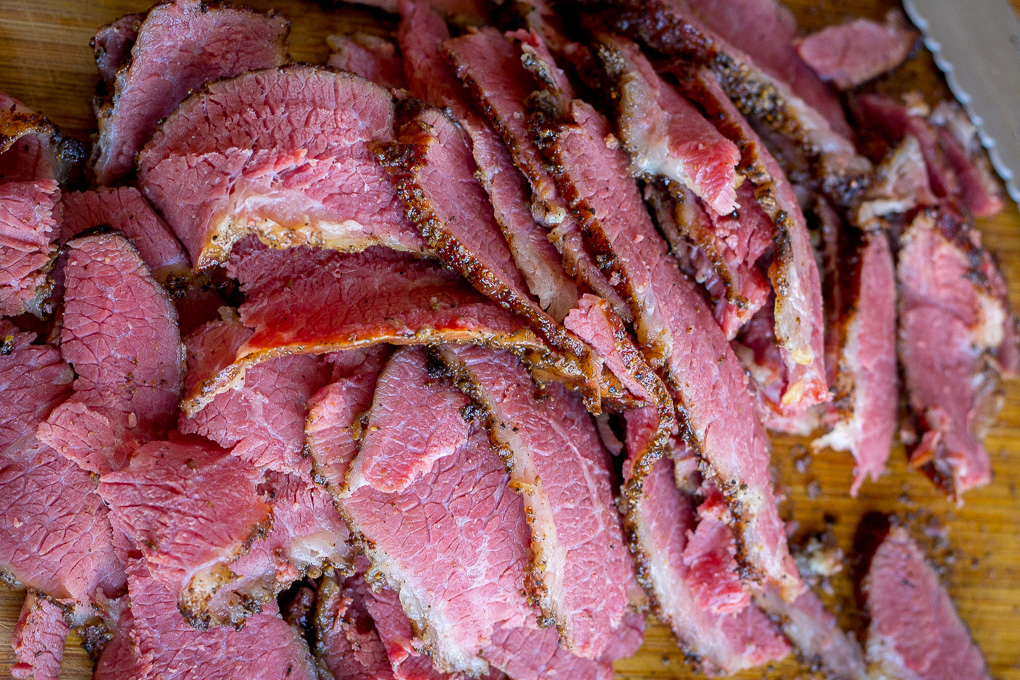
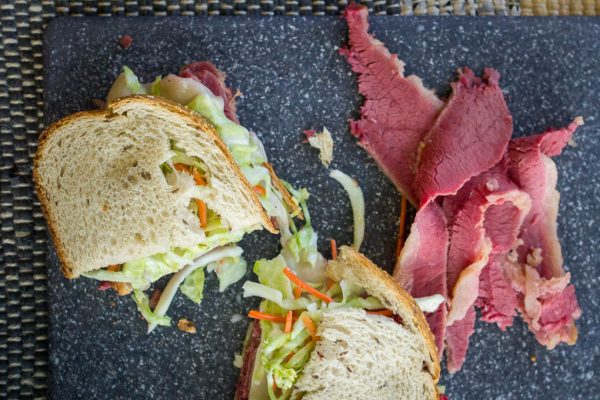
| Prep Time | 30 minutes |
| Cook Time | 8 hours |
| Passive Time | 5 days |
| Servings |
|
- 4 lb beef brisket trimmed of excess fat
- 12 oz kosher salt
- 1.5 tbsp pink curing salt aka Prague Powder #1 (see notes)
- 1/2 c brown sugar
- 2 tbsp pickling spice see notes
- 3 q water
Ingredients
|

|
- Heat the water, salt, curing salt, brown sugar, and pickling spice over medium-high heat until the sugar and salts are completely dissolved.
- Remove from heat and let the mixture cool completely.
- Put the brisket in a large Ziploc bag and cover with the liquid. Alternately, you can use a container with a tight-fitting lid, but the bag is preferable.
- Refrigerate for at least 5 days. Flip the meat or otherwise adjust it daily if necessary to make sure it's adequately covered.
- FOR ALL COOKING METHODS: Take the meat out of the refrigerator, remove from the brine, and rinse it thoroughly under cold water. Pat dry with paper towels.
- SLOW COOKER: Place brisket into a slow cooker with carrots, cabbage, potatoes, and onion (as desired). Cover with water by about 1 inch and cook on high for 8 hours.
- OVEN: Place the brisket in a baking dish and add about an inch of water (or beer, or other liquid of your choice), and tent with foil. Cook at 275 degrees for 4-6 hours, until an internal temperature of 185 degrees is reached.
- SOUS VIDE: Seal the brisket in a vacuum-sealed bag and cook at 170 degrees for 10 hours (alternately, 185 degrees for 8 hours).
- Pink curing salt (aka Prague Powder #1) contains a good amount of Sodium Nitrite, which is what makes it work but also makes it TOXIC if directly ingested. So please use it only as described and store it somewhere safe so you don't accidentally sprinkle it on your french fries.
- Find my recipe for pickling spice here.
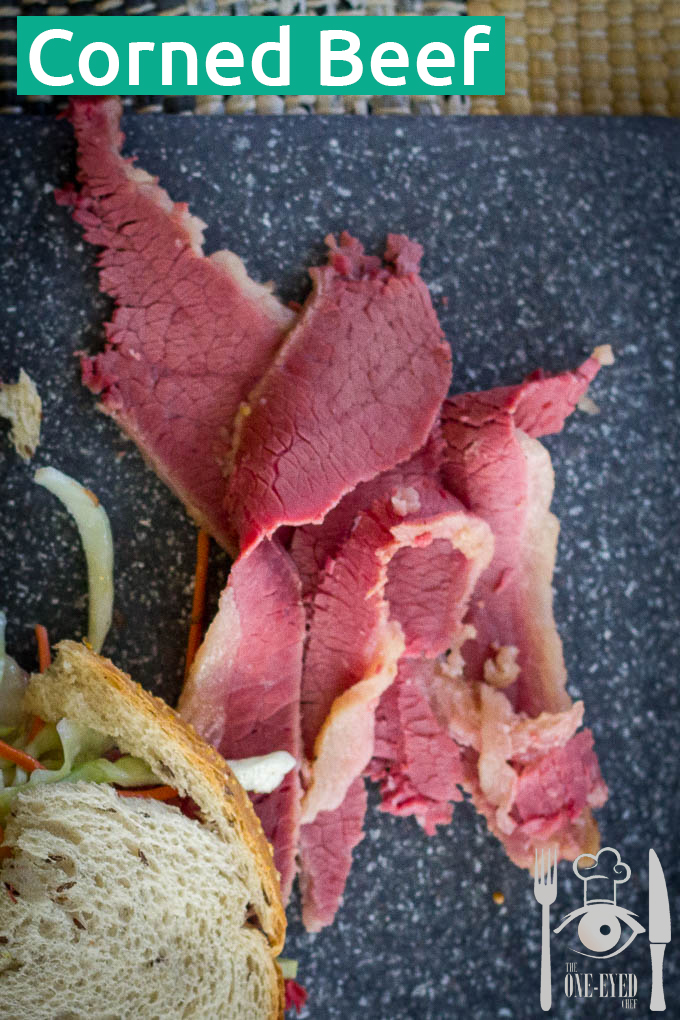


I figure that you’re trying to play it safe with your content, but please remember that the more controversial musings always start a good dialogue when approached with respect..and this IS your site after all, allow your content be King here!
There’s noticeably a bundle to know about this. I assume you made certain nice points in options also.